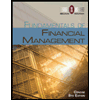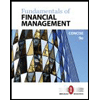
Financial Ratio Analysis A financial ratio by itself tells us little about a company because financial ratios vary a great deal across industries. There are two basic methods for analyzing financial ratios for a company: Time trend analysis and peer group analysis. In time trend analysis, you find the ratios for the company over some period, say five years, and examine how each ratio has changed over this period. In peer group analysis, you compare a company’s financial ratios to those of its peers. Why might each of these analysis methods be useful? What docs each tell you about the company’s financial health?
To discuss: Usefulness of time trend analysis and peer group analysis and their aspects on the company’s financial health.
Introduction:
Peer group analysis compares the operating performances and financial ratios of specific firms to a set of peer group companies within the similar business line or industry.
Time trend analysis compares the financial statement of the company’s historical data with that of forecasted data.
Explanation of Solution
Peer group analyses are the companies with same set of interest and characteristics and it compares the financial ratios of the company to its peers. Peer group analysis provides a comparison with the other peer groups with respect to operating performance and financial ratios. This will lead the financial managers to evaluate whether the investment, finance, operations of the firm goes beyond the norms and brings some actions or guidance to rectify them.
Time trend analysis compares its own historical data with the forecasted data. This helps the financial managers to evaluate whether the investment, finance, and operations of the firms are changed.
On the other hand, both these methods evaluate the company’s performance from the perspective of finance but have not a clear picture whether it is positive or negative.
Time trend analysis and peer group analysis indicates the difference with respect of the investment, finance, operations of the firm and does not indicate whether it is good or bad to the company. Hence, it is useful to know the financial health of the company.
Want to see more full solutions like this?
Chapter 3 Solutions
CORPORATE FINANCE (LL+CONNECT)
- How does the weighted average cost of capital (WACC) impact investment decisions?no aiarrow_forwardWhat is the difference between operating leverage and financial leverage in finance?arrow_forwardHow does the weighted average cost of capital (WACC) impact investment decisions?need help.arrow_forward
 Financial And Managerial AccountingAccountingISBN:9781337902663Author:WARREN, Carl S.Publisher:Cengage Learning,
Financial And Managerial AccountingAccountingISBN:9781337902663Author:WARREN, Carl S.Publisher:Cengage Learning, Managerial Accounting: The Cornerstone of Busines...AccountingISBN:9781337115773Author:Maryanne M. Mowen, Don R. Hansen, Dan L. HeitgerPublisher:Cengage Learning
Managerial Accounting: The Cornerstone of Busines...AccountingISBN:9781337115773Author:Maryanne M. Mowen, Don R. Hansen, Dan L. HeitgerPublisher:Cengage Learning Fundamentals of Financial Management, Concise Edi...FinanceISBN:9781285065137Author:Eugene F. Brigham, Joel F. HoustonPublisher:Cengage Learning
Fundamentals of Financial Management, Concise Edi...FinanceISBN:9781285065137Author:Eugene F. Brigham, Joel F. HoustonPublisher:Cengage Learning Fundamentals of Financial Management, Concise Edi...FinanceISBN:9781305635937Author:Eugene F. Brigham, Joel F. HoustonPublisher:Cengage Learning
Fundamentals of Financial Management, Concise Edi...FinanceISBN:9781305635937Author:Eugene F. Brigham, Joel F. HoustonPublisher:Cengage Learning EBK CONTEMPORARY FINANCIAL MANAGEMENTFinanceISBN:9781337514835Author:MOYERPublisher:CENGAGE LEARNING - CONSIGNMENT
EBK CONTEMPORARY FINANCIAL MANAGEMENTFinanceISBN:9781337514835Author:MOYERPublisher:CENGAGE LEARNING - CONSIGNMENT





